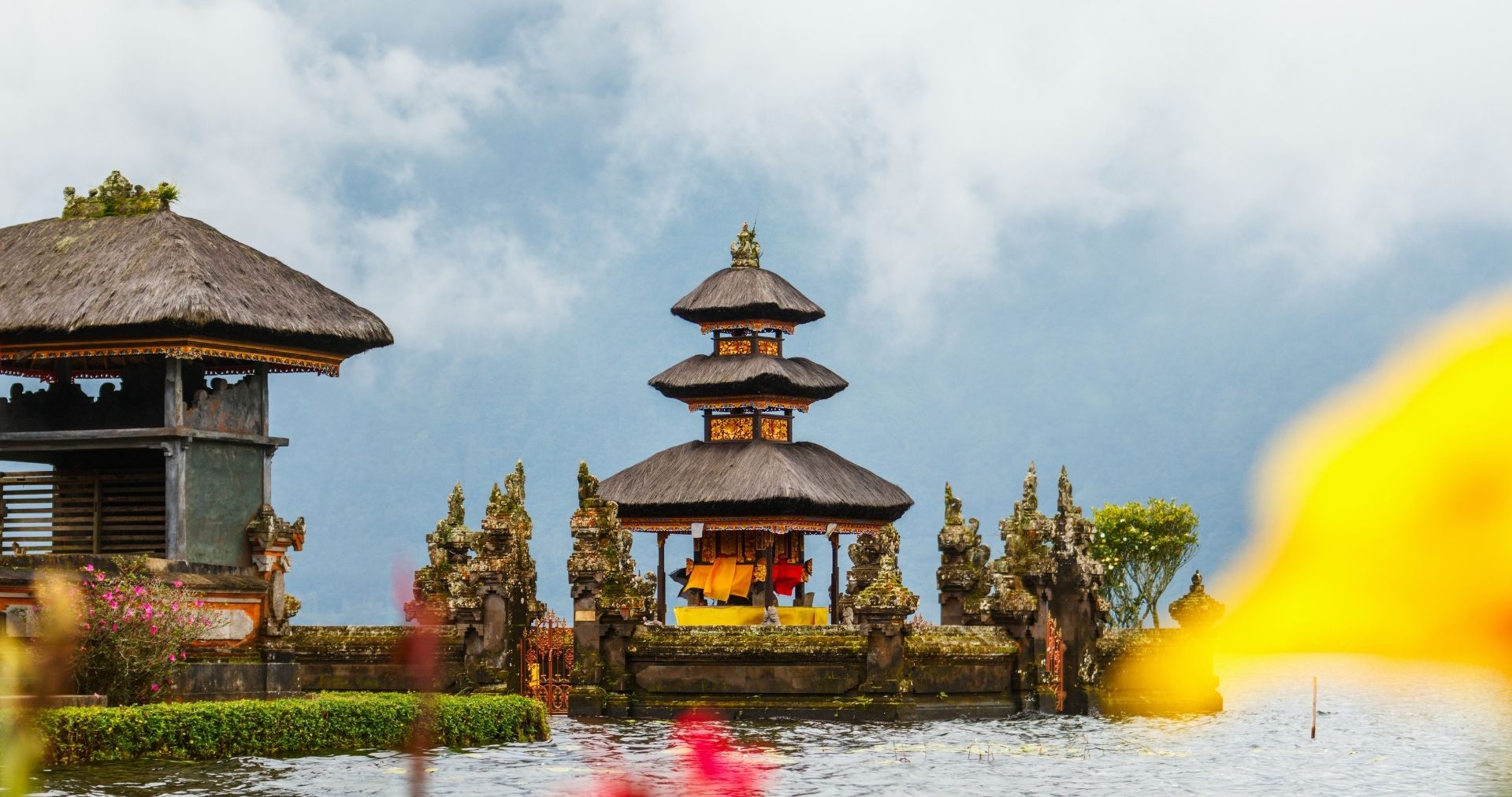
Indonesia
Indonesia, the world’s largest archipelago, is home to over 17,000 islands, 300 ethnic groups, and 700 languages, making it one of the most diverse travel destinations on Earth. From the ancient temples of Java and the pristine beaches of Bali to the tribal cultures of Papua and the wildlife-rich jungles of Sumatra, Indonesia offers endless adventures. Whether you’re drawn to volcano trekking, island hopping, or cultural exploration, Indonesia is a land where nature, tradition, and history come together to create unforgettable journeys.
Top Things to Do in Indonesia
Born of Fire, Bound by Faith
Long ago, under Mount Bromo’s watchful eye, Princess Roro Anteng and Joko Seger ruled a prosperous land — but longed for a child. They climbed to the crater’s edge and begged the mountain gods for help. The gods agreed, but with one condition: their last-born must be given back to the fire.
Twenty-five children came, and when the time came to surrender the youngest, Kesuma, the parents could not. The mountain shook in fury, ready to spew fire. To appease the gods, they kept their promise — and Kesuma was cast into the fiery pit, her voice echoing from the depths, urging her people to always remember. Even today, the descendants of the king and queen keep that vow alive — casting offerings into the crater to honour Kesuma’s final words.
Ready to witness a legend kept alive in smoke and ash?
Of Kings, Ghosts, and Coral Thrones
They say it began in the folds of the jungle — where a woman found seven eggs. No one knows who placed them there. Four cracked open and birthed kings, shaped by wind, reef, salt, and sky. Each sailed to a waiting island: Salawati, Batanta, Waigeo, and Misool. And so, the legend of Raja Ampat — the Four Kings — was born.
The remaining three became a Ghost, a woman, and a stone. The ghost guards the waters, guiding fishermen safely home. The woman vanished into the forest, becoming the islanders’ first ancestor. The final egg became a sacred stone, said to rest in a hidden cave known only to elders. Together, these seven forms — kings, spirit, woman, and stone — hold the balance of human, spirit, and nature that shapes the soul of Raja Ampat.
Will you follow the waves to where legends are guarded by reef and rain?
Where the Sky Once Spoke
Before the Manggarai had villages, they had only the wind and the stars. They wandered the hills, untethered — until a dream came to a man named Empu Maro. In his sleep, the sky whispered: “Build a home that touches us.” Seven levels, they said — for earth, fire, wind, water, ancestors, spirits, and sky. A house not just for people, but for all that holds them.
So they built it — tall, conical, thatched with forest and faith. When it rose, the clouds descended, draping the house in mist. The gods had found their way inside. And so the Manggarai stayed — beneath a roof where stories echo, and the sky still listens.
Are you ready to stand where dreams once shaped a village in the clouds?
Where Waters Remember
The legend tells of the god Indra, who pierced the earth to release holy water — tirta — to revive his poisoned soldiers and wash away the demon’s curse. From this cosmic act, the tradition of Melukat, or ritual purification, was born.
Each spout, flowing from the carved mouths of guardians, holds a distinct energy — one to cleanse sorrow, one to dispel illness, another to realign the spirit. Pilgrims wait in silence, guided by priests, stepping from one stream to the next in a ritual that is at once personal and ancient.
Want to uncover the clarity these sacred waters have been saving just for you?
Keepers of the Canopy
They say the forest speaks in rustles and shadows. And if you listen long enough, you’ll hear the soft rustling of the old ones — Orangutans, whose name means “person of the forest.” In the misty jungles of Kalimantan, they move through the trees with unhurried grace, as if time itself slows to match their rhythm. Mothers cradle their young like forest queens, teaching the wisdom of the canopy — what to eat, how to move, when to disappear.
The Dayak people believe orangutans were once human — spirits who chose the trees over towns. To harm them is to harm the forest itself. Here, in this living cathedral of green, spotting an orangutan is more than a sighting — it’s an encounter with something ancient.
Will you walk into the forest and meet the ones who chose silence?
The Dance of the Spirits
In times of sickness, drought, or unrest, elders in remote Bali villages turned to this trance-inducing chant. Young women — often called pemangku sanghyang — would become mediums, believed to be possessed by protective spirits. Around them, men sat in a circle, echoing ancient syllables — cak-cak-cak — in a rising tide of sound. Their chant wasn’t just music. It was a force. A plea. A shield.
The purpose? To repel misfortune, heal the sick, or receive divine guidance. These weren’t performers. They were guardians — of balance, belief, and the space between seen and unseen. It was only in the 1930s that this entrancing form was adapted into the now-famous Kecak dance, blending sacred trance with Hindu epic — a performance born of protection.
Curious to experience a ritual where voices carry stories older than time itself?
Indonesia Travel by Season
Indonesia stretches across the equator with over 17,000 islands—each with its own rhythm, rituals, and revelations. The country moves between two tropical moods: the dry winds and the lush downpours and a shoulder season.

Musim Peralihan / Shoulder Season
April and November
Lush landscapes, fewer travellers, ideal for slow explorations and sacred rituals.
Recommended Destinations:
Lombok, Nusa Penida, Labuan Bajo, and Toraja

Musim Hujan / Wet Season
December to March
Rain-kissed jungles, misty mornings, vibrant ceremonies, and quiet spiritual reflections.
Recommended Destinations:
Ubud, Raja Ampat, Tana Toraja, and Bukit Lawang

Musim Kemarau / Dry Season
May to October
Clear skies, crisp air, perfect for temples, trekking, diving, and cultural festivals.
Recommended Destinations:
Bali, Komodo Islands, Yogyakarta, and Mount Bromo
Indonesia Travel: FAQs
What is the best time to visit Indonesia for travellers?
The best time to visit Indonesia is during the dry season, from May to September. This period is ideal for beach holidays in Bali, diving in Komodo, and exploring cultural sites in Yogyakarta. The rainy season (October to April) sees higher humidity and occasional downpours, but destinations like Bali remain popular year-round.
How many days are enough for Indonesia?
Indonesia is vast, with over 17,000 islands, so the ideal duration depends on your interests. For a first trip, 7 to 10 days are enough to explore Bali and nearby islands. With 2 to 3 weeks, travellers can add destinations like Java, Lombok, Komodo, or Sumatra for a deeper experience.
What kind of traveller is Indonesia ideal for?
Indonesia suits every type of traveller. It’s perfect for beach lovers, adventure seekers, divers, surfers, and cultural explorers. Families enjoy Bali’s resorts, couples choose the islands for romantic getaways, while solo travellers often come for yoga retreats, trekking, and diving.
What is Indonesia famous for?
Indonesia is famous for Bali’s beaches and temples, Komodo dragons, the cultural heritage of Yogyakarta, and world-class diving in Raja Ampat. It’s also known for its vibrant festivals, ancient temples like Borobudur, and its cuisine, from nasi goreng to satay. Many travellers come for the unique blend of natural beauty and spiritual traditions. Indonesia is also a global hub for wellness, with Bali in particular offering spiritual healing, yoga, meditation, and traditional practices aimed at holistic rejuvenation.
Is Indonesia part of Asia or Oceania?
Indonesia is part of Southeast Asia, but its easternmost islands stretch into Oceania. It sits along the equator, between the Indian and Pacific Oceans. This strategic location has shaped its diverse culture, with influences from Asia, the Pacific, and the Middle East.
Do Indian travellers need a visa to visit Indonesia?
Indian travellers need a visa to visit Indonesia. A visa-on-arrival is available for short stays of up to 30 days, which can be extended once. The process is straightforward, and e-visas are also available online. Always confirm updated requirements before travelling, and you can check the official Indonesia visa portal.
What currency is used in Indonesia, and can travellers use US dollars or credit cards?
The official currency of Indonesia is the Indonesian Rupiah (IDR). Credit and debit cards are widely accepted in cities, resorts, and larger restaurants, but cash is recommended for local markets, taxis, and smaller islands. ATMs are available in most tourist areas.
What language is spoken in Indonesia?
The official language of Indonesia is Bahasa Indonesia. English is commonly spoken in tourist regions like Bali, Jakarta, and Yogyakarta, especially in hotels and restaurants. In more remote islands, English is limited, but travellers often find communication easy with the hospitality of locals.
What local etiquette should travellers follow in Indonesia?
Indonesians are friendly and polite, and travellers are expected to respect local customs. Dress modestly when visiting temples or rural areas, remove shoes before entering homes or places of worship, and use both hands when giving or receiving items. Avoid public displays of affection in conservative regions.
What should travellers know about Indonesian food and dietary options?
Indonesian cuisine is rich and diverse, with regional specialties across the islands. Nasi goreng (fried rice), mie goreng (noodles), rendang, and satay are must-try dishes. Vegetarians will find options like gado-gado (vegetable salad with peanut sauce). In Bali and Jakarta, vegan and international cuisines are widely available.
Is Indonesia budget-friendly, and how much should travellers budget per day?
Yes, Indonesia is budget-friendly. Backpackers can travel comfortably on $25–$40 per day, covering hostels, local meals, and public transport. Mid-range travellers may budget $50–$90 per day for boutique hotels, guided tours, and fine dining. Luxury travel starts around $150+ per day, especially in Bali or private island resorts.
What are the main airports in Indonesia for international travellers?
Key international airports include Soekarno-Hatta International Airport (Jakarta), Ngurah Rai International Airport (Bali), and Juanda International Airport (Surabaya). These airports are well connected to Asia, Australia, and Europe. From these hubs, domestic flights link to smaller regional airports, allowing easy exploration of the archipelago.
How easy is it to travel around Indonesia?
Indonesia is an archipelago, so travel involves a mix of flights, ferries, trains, and road transport. Domestic airlines like Garuda Indonesia, Lion Air, and Batik Air connect major islands such as Java, Bali, and Sumatra. Ferries link islands like Bali–Lombok or Java–Sumatra. In cities, taxis, ride-hailing apps like Gojek or Grab, and scooters are common for short distances. Renting a motorbike is popular in Bali and Lombok but requires caution.
Is it safe and legal for foreigners to rent motorbikes in Indonesia?
Yes, foreigners can rent motorbikes, but it’s advisable to have an international driving permit (IDP). Helmets are mandatory, and traffic can be chaotic in cities like Jakarta or Bali. Daily rentals range from $5–$10. For those unfamiliar with local traffic patterns, hiring a driver or using Gojek/Grab motorbike services is safer.
What is the connectivity like between major cities and islands in Indonesia?
Indonesia has excellent domestic connectivity. Flights are the fastest way to cover long distances between islands like Java, Bali, Lombok, Sumatra, and Sulawesi. Ferries serve shorter routes and provide scenic journeys. Within cities, ride-hailing apps, taxis, and buses make commuting easy and affordable.
Discover our carefully curated selection of itineraries to indulge your happy feet. Embark on a journey of discovery in the most intimate setting tailored to your travel needs.
Inspired by what you see? Connect with us to design a meticulously curated journey with our travel ARTHitect — the journey of your dreams is just a conversation away.
